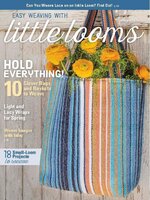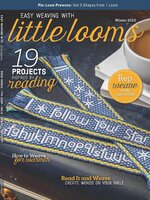Easy Weaving with Little Looms is a perennial favorite. By popular demand, it will now be available by subscription. Each issue will have the mix of 18–22 projects, techniques, and features you love, expanding the focus on fundamental weaving skills, creative inspiration, and innovative applications. Each issue is designed to have something for beginning and more experienced weavers. In addition to the core subjects of rigid-heddle and pin-loom weaving, Little Looms regularly includes projects and articles about tapestry, tablet weaving, and inkle weaving.
Little Looms • Winter 2022 Issue 4
EDITORIAL
FANCY FINDINGS • For the bookworm who weaves, these tools and accessories celebrate the love of reading.
BOOKS FOR LITTLE WEAVERS • Weaving books don’t have to be how-to books written for adults; they can also be colorful and beautifully illustrated works of fiction or nonfiction for children. What better way to introduce the future weavers in your life to fiber than through books written just for them?
ARRAY A VERY SPECIAL TAPESTRY YARN • Wool tapestry yarns need to be firm to hold up to strongly tensioned warp ends and are typically made from long-staple fibers. You might find short, crimpy wools in yarns designed for knitting, where a soft hand and elasticity are valued. Longer-staple wools are strong, smooth, and have less elasticity, making them ideal for weft in hard-wearing tapestries and rugs. In addition to adding strength, long fibers reflect more light than shorter fibers, a quality that is important in tapestry weaving. That’s why I was so excited when Gist Yarn, a Boston-based company, announced it would be developing a new yarn for tapestry weavers. Fast-forward a couple of years and meet Array.
Holiday Gift Guide • Need the perfect gift this season for the weaver in your life? Whether for you or someone else, these are some of our favorites!
TAPESTRY TALK: HATCHING • In a previous article, I discussed the meet-and-separate method in tapestry (Easy Weaving with Little Looms, Summer 2022). In this article, I’ll explain how to use meet and separate in a technique called hatching. Hatching can suggest transparency, make subtle transitions between colors, and even be bold and graphic. I think you’ll find it a method you’ll want to explore as you develop your tapestry-weaving tool kit.
THE SCIENCE OF WARMTH • The turn of the last century was the heroic age of Antarctic exploration. Amundsen, Scott, Shackleton, and their teams traversed unknown icy lands and waters, battling frigid elements. Frostbite and hypothermia were constant fears. Looking at photos of these men, you see determination but also utter cold and exhaustion on their chapped faces.
THE POWER OF PICK-UP STICKS • Have you ever wanted to try using pick-up sticks but weren’t sure where to begin, or you found them intimidating? This tutorial will take you through the process of weaving with a pick-up stick on a rigid-heddle loom. You’ll experiment with a couple of patterns and learn tips and tricks along the way. Let’s jump in!
CONTINUOUS-STRAND WEAVING • When pin-loom weavers are starting on their journey, they often begin with a 4-by-4-inch square loom. Soon they realize that, while you can make many projects using squares and clever folding, weaving only one shape is limiting. If looms in other shapes aren’t in the budget quite yet, there is a way to weave not only squares but also triangles and rectangles on a square loom: continuous-strand weaving.
POWERFUL prose • Discover a new book or rediscover an old favorite with these projects reminiscent of the literature we love.
CUPPA TEA COZY
MEGHALAYA SCARF
NAMESAKE RUNNER
INCENSE AND SENSIBILITY COWL
All Access Subscribers Get More • Weaving resources, exclusive weaving libraries, 125+...

 Summer 2025
Summer 2025
 Spring 2025
Spring 2025
 Winter 2024
Winter 2024
 Fall 2024
Fall 2024
 Summer 2024
Summer 2024
 Spring 2024
Spring 2024
 Winter 2023
Winter 2023
 Fall 2023
Fall 2023
 Summer 2023
Summer 2023
 Spring 2023
Spring 2023
 Winter 2022
Winter 2022
 Fall 2022
Fall 2022
 Summer 2022
Summer 2022